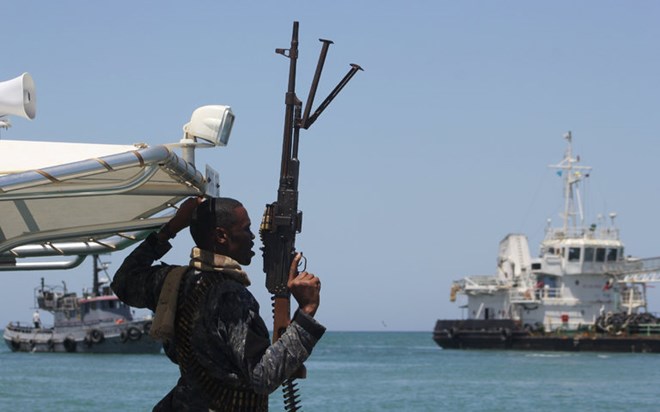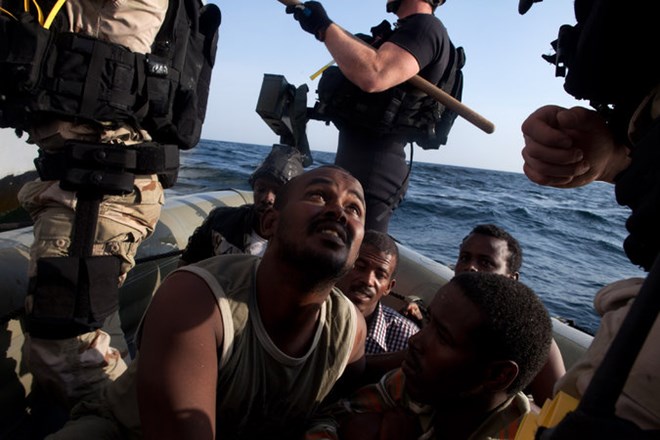
Wednesday April 5, 2017
Are the pirates back?
After years of quiet seas, undisturbed voyages and no major attacks, Somali pirates have waylaid four ships in the past month, raising fears that the pirate menace has returned to the Indian Ocean.
A Pakistani-owned cargo vessel carrying food was hijacked off the coast of central Somalia, Somali officials said on Tuesday, just days after an Indian cargo ship was commandeered and dragged to an infamous pirate den.
Analysts said a number of factors had driven the resurgence in piracy, including drought, famine, corruption, a surge of smuggled weapons and the influence of the Islamic State.
All of the recent attacks, including a hijacked oil tanker last month, are believed to have been carried out by buccaneers from central Somalia or Puntland, a semiautonomous region in northeastern Somalia.
“Puntland’s facing a lot of problems right now,” said Mohamed Mubarak, who runs a Somali anticorruption organization, Marqaati, which means “witness.”
“In many coastal towns, there is no government presence,” he said. “You can do whatever you want. Pirates and criminal gangs now have space.”
Pirates are as old as the seas. But the modern-day Somali pirate problem started around 2008, when bands of former fishermen began speeding into Somalia’s waters in busted-up skiffs and leaky dinghies, hijacking whatever crossed their paths. Typically, pirates would scamper aboard a ship at night, rush to the pilothouse and commandeer the vessel at gunpoint. The pirates then sailed back to their lairs along the coast and waited for shipping companies to pay a ransom to free the crew.
Often the money literally fell from the sky. Several companies in nearby Kenya specialized in shrink-wrapping million-dollar blocks of cash and delivering them by parachute.
The pirates, no fools about public relations, even had spokesmen who elucidated their motives. (It was all about the money.) In many cases, their operations were financed by wealthy businessmen eager to exploit poor, desperate young men, many of whom could not even swim.
From 2008 to 2012, there were hundreds of attacks, and the pirates, and their financiers, made a fortune in ransoms. Countless pirates also drowned. There was even one pirate organization called The Corporation that supposedly printed a guidebook outlining a pirate code of conduct.
As the years passed, the shipping companies wised up. They invested heavily in hiring armed guards, who showed no hesitation at blasting the fiberglass skiffs out of the water.
At the same time, a coalition of foreign navies beefed up patrols, sometimes burning a million dollars of fuel each day to go back and forth along Somalia’s craggy coastline, which, at 1,880 miles, is the longest on mainland Africa.
Aid organizations also joined the cause, coming up with alternatives for the thousands of young men who had become pirates. Fishery projects were started, along with vocational training. The increased risk and new jobs opportunities drew people — and financing — away from the buccaneering business.
But those programs may have been a victim of their own success, Mr. Mubarak said. After years of declining attacks, resources were moved away from patrolling Somalia’s coast. Instead, those funds were used to battle other threats, including the Islamic State, which recently invaded coastal towns in Puntland.
Another factor may be politics. Somalia recently selected a new Parliament and a new president in a long, drawn-out process that was widely believed to have been one of the most corrupt political events in Somalia’s history.
“High officials are involved in this,” said Abdirazak Fartaag, a former Somali government official.
He said government officials were most likely colluding with the pirates for a cut of the ransom, which was also the case years ago.
“I know the mind-set,” he said. “I know the game that exists in our country.”
Somali officials said the Indian cargo ship that was seized last week was now being held for ransom in the El Hur area of central Somalia, south of the Puntland border, a well-known pirate locale. The Pakistani-owned boat carrying food was headed toward the Somali coast, though it was not clear exactly where.
In March, pirates hijacked an oil tanker and temporarily detained its Sri Lankan crew before releasing the boat and the men without conditions, Somali officials said at the time. Later that month, pirates attacked a large fishing vessel with the plan of using it as a floating base to hijack even bigger ships.
After several stingy rainy seasons, Somalia is on the verge of famine, with hundreds of thousands of people rapidly running out of food.
“Hunger is pushing people into crime,” Mr. Mubarak said. “It’s making a lot of people look for something.”
Other analysts said that more illegal foreign fishing vessels were plying the waters off Somalia’s coast, pestering Somali fishermen and possibly turning some toward violence.
At the end of the day, analysts said, Somali piracy is a business decision. Rich merchants in central Somalia and Puntland must have decided that after years of being a money-losing operation, there were riches to made again in high-seas piracy.


